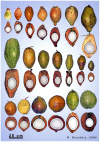Fruit Biology of Coconut (Cocos nucifera L.)
- PMID: 36501334
- PMCID: PMC9738799
- DOI: 10.3390/plants11233293
Fruit Biology of Coconut (Cocos nucifera L.)
Abstract
Coconut (Cocos nucifera L.) is an important perennial crop adapted to a wide range of habitats. Although global coconut demand has increased sharply over the past few years, its production has been decreasing due to palm senility, as well as abiotic and biotic stresses. In fact, replanting efforts are impeded due to the lack of good quality seedlings. In vitro technologies have a great potential; however, their applications may take time to reach a commercial level. Therefore, traditional seed propagation is still critical to help meet the rising demand and its practice needs to be improved. To achieve an improved propagation via seeds, it is important to understand coconut fruit biology and its related issues. This review aims to provide a comprehensive summary of the existing knowledge on coconut fruit morpho-anatomy, germination biology, seed dispersal, distribution, fruit longevity and storage. This will help to identify gaps where future research efforts should be directed to improve traditional seed propagation.
Keywords: coconut; germination; palms; propagation; seed.
Conflict of interest statement
The authors declare no conflict of interest.
Figures





References
-
- Niral V., Jerard B. Botany, Origin and Genetic Resources of Coconut. In: Nampoothiri K.U.K., Krishnakumar V., Thampan P.K., Nair M.A., editors. The Coconut Palm (Cocos nucifera L.)-Research and Development Perspectives. Springer; Singapore: 2019. pp. 57–111.
-
- Thomas G.V., Krishnakumar V., Dhanapal R., Reddy D.S. Agro-management Practices for Sustainable Coconut Production. In: Nampoothiri K.U.K., Krishnakumar V., Thampan P.K., Nair M.A., editors. The Coconut Palm (Cocos nucifera L.)-Research and Development Perspectives. Springer; Singapore: 2019. pp. 227–322.
-
- Adkins S., Foale M., Harries H. Encyclopedia of Life Support Systems, Developed under the Auspices of UNESCO. Eolss Publishers; Oxford, UK: 2011. [(accessed on 20 January 2022)]. Growth and Production of Coconut. Soils, plant growth and crop production; p. 7. Available online: http://www.eolss.net.
-
- Samosir Y., Foale M., Adkins S. Coconut Revival—New Possibilities for the ‘Tree of Life’, Proceedings of the International Coconut Forum, Cairns, Australia, 22–24 November 2005. Volume 125. ACIAR; Canberra, Australia: 2006. Australian involvement in coconut research and development; pp. 36–42.
-
- Samosir Y.M., Adkins S.W. Improving acclimatization through the photoautotrophic culture of coconut (Cocos nucifera) seedlings: An in vitro system for the efficient exchange of germplasm. In Vitro Cell Dev. Biol. Plant. 2014;50:493–501. doi: 10.1007/s11627-014-9599-z. - DOI
Publication types
Grants and funding
LinkOut - more resources
Full Text Sources
Miscellaneous

